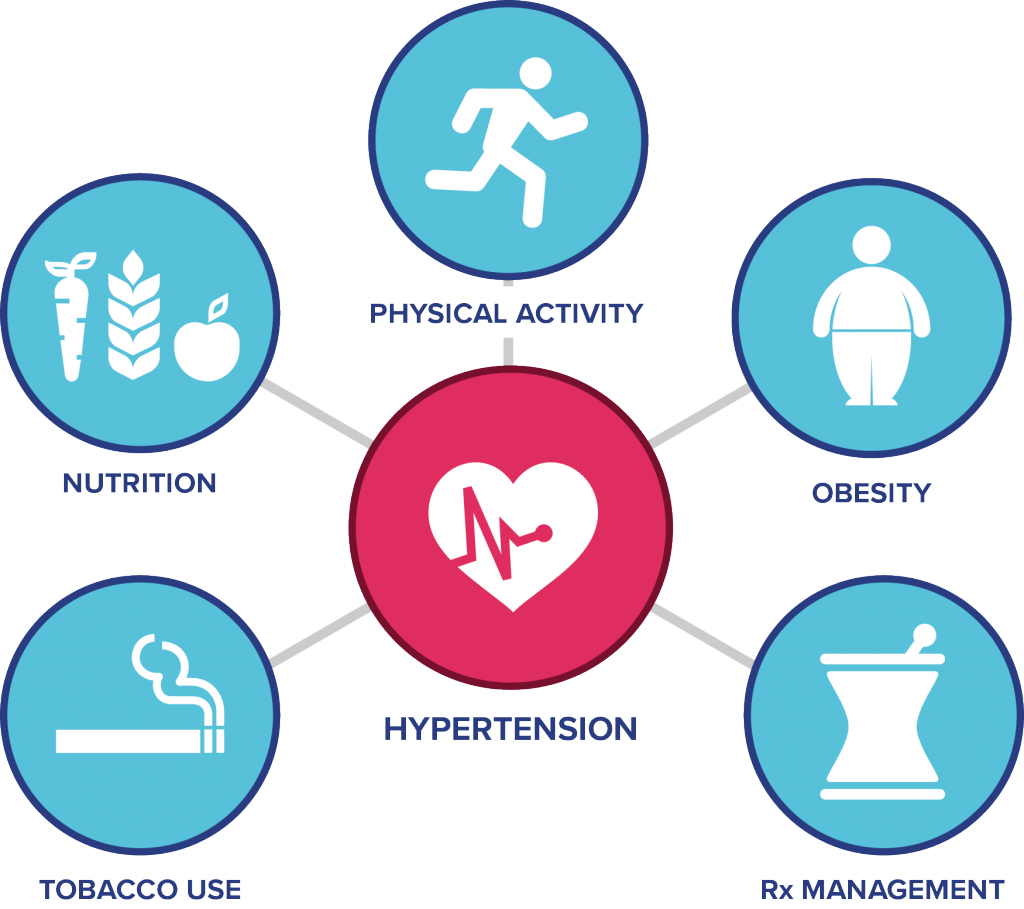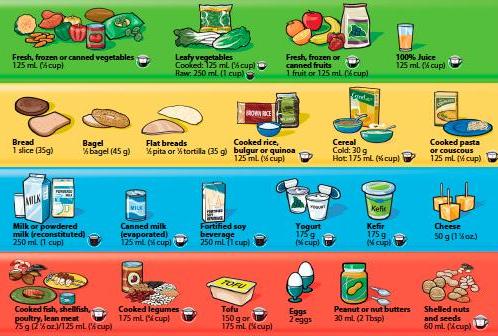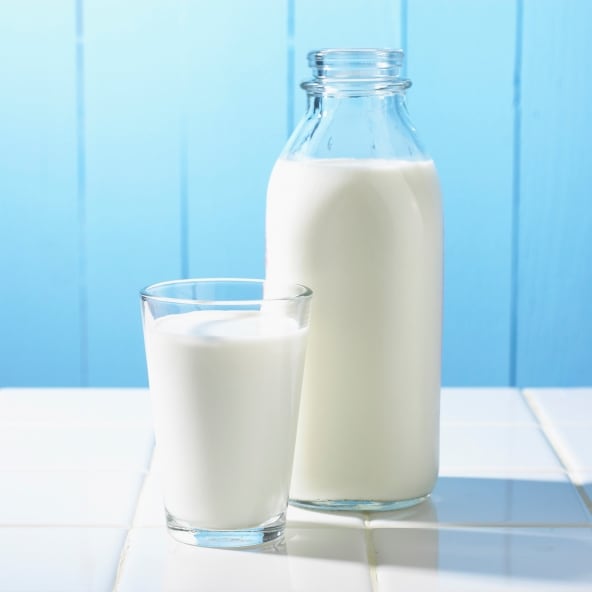Nutrition
Nutrition Labels
Posted on August 22, 2018 by admin
Food and nutrition labels provide consumers with a lot of useful information. To start off, ingredient lists are sorted by weight. The first item shown on the ingredient list weighs the heaviest in the product and continues in descending order. This is helpful for consumers who are looking for a specific ingredient that they want more or less of. When we read a nutrition facts table, the information on it are based on serving sizes. Serving sizes allow us to compare nutritional values between similar products, know how much of a specific nutrient we are consuming, and give us a better idea of how much food we are eating.

Every nutrition label shows the serving size, the amount of calories, and 13 nutrients (fat, saturated and trans fat, cholesterol, sodium, carbohydrates, fiber, sugars, protein, vitamin A, vitamin C, calcium, and iron). The percentage of your daily value or “%DV” is based on the suggested serving size. It is considered a large amount if it is more than 15% and it is a very small amount if it is less than 5%. Lastly, calories equal the amount of energy in food and fats, protein, and carbohydrates provide us the energy to complete our daily activities. Overall, it is important to look at the serving sizes before we look at calories or a certain nutrient.
It’s Never too Late to Set SMART Goals
Posted on September 5, 2017 by admin
For many of us, today is the first day back to school! Have you considered setting new SMART goals for the start of the school year? It is common to set SMART goals for yourself in the new year however it is not too late to create new goals in September!
Haven’t heard of SMART goals before? They are goals that are more specific and are more measurable throughout your progress. How do you know if your goals are SMART?

Specific: Create detailed, concise and clear goals of what needs to be achieved with a fully constructed result.
Measurable: How will you be able to keep track of your progress?
Achievable: Is this goal realistic? Are you able to attain this goal within the reasonable amount of time mentioned in the goal?
Relevant: Is there a purpose along with the goal you have made? Is it the right time to set this goal and are you able to continue going through with the goal?
Timely: How soon or long will it take to complete your goals? Is it a reasonable period of time for you to attain them?
Following these criteria can create detailed goals and tracking your process can become a lot easier as you allow yourself a set time to accomplish these goals!
Hypertension
Posted on July 31, 2017 by admin
Hypertension, also known as high blood pressure, can be quite life-threatening if the conditions are not controlled. Hypertension is when your arteries are experiencing higher-than-normal pressure which causes extra stress on the vessel walls. A normal blood pressure is approximately 120/80 mmHg. For this condition to become If the walls are damaged or has a tear then other health problems can occur such as Atherosclerosis. High blood pressure can affect the function of other organs and can cause heart failure leading to heart attacks and strokes.
A reason why this condition is dangerous because there are usually no symptoms so many individuals will not know if they have hypertension until something serious occurs or if they visit their family doctor.
There are many factors that contribute to high blood pressure, including drinking alcohol on a regular basis, over consumption of salt, not enough physical activity and obesity, or having hypertension in family history.

If caught early, you can control your lifestyle and lower your blood pressure.
Changing your diet and the amount of physical activity you do can greatly impact your blood pressure. Consider having meals with less sodium and reduce your alcohol intake. When exercising, try to maintain 30 minutes of physical activity everyday which can help lower your blood pressure. Even learning to manage your stress can greatly reduce the pressure on your vessel walls.

Healthy Eating
Posted on July 12, 2017 by admin
Many of us do not exceed the minimal intake of nutrients we need daily. Some of us consume too much sugar and fats that our bodies actually require and that can lead to health problems. Many individuals tend to lean towards dieting in order to lose weight and some individuals continue to stay on their current diet and exercise at the gym instead. Both of these situations may cause harm to your body even if you do not notice the changes. We always hear people telling us to eat healthy or go on a healthy diet but what does it consist of?
Firstly, there is the Food guide we can refer to. Taking the recommended servings in each age group and food group is a great start to help your body get what it needs for energy.

If you are not confident about the servings you are consuming daily, then why not learn to cook healthy meals at home? This way, it is easier to measure how many servings of each food group you are consuming and you tend to know more about the ingredients you are using while making a home-cooked meal. Cooking a meal at home also lets you head out to the grocery store and know the products you are buying and consuming. Some food products can be local while some are not. Some restaurants do not indicate where their source of food is coming from but some grocery stores indicate whether their source of food coming is locally or not.
Some individuals like to go on a diet to help lose weight and become healthier but they also avoid carbohydrates. However, carbohydrates are good for your diet and some are healthier than others. There are 3 types of carbohydrates: sugar, starch, and fiber. Sugar has the highest glycemic index compared to all three carbohydrates, meaning it has the potential to raise your blood sugar level the easiest.

How can we incorporate carbohydrates into our healthy diet?
Our body uses glucose for energy and we get glucose from carbohydrates. This is why it is important to consume carbohydrates in our diet and not eliminate them in order to lose weight. We need to know which carbohydrates are healthy and good for us and which ones that are bad for us. Consuming fresh fruits and vegetables are good for us. This is because there are not added sugar in these produce. When trying to take in starch, choose whole grains or legumes since they have a lower glycemic index and contain nutrients that your body requires such as B vitamins and fiber. Sugar is still important for your body to function but it only requires a small amount so limiting your sugar intake would be beneficial.
Calcium and Vitamin D
Posted on June 6, 2017 by admin
Calcium plays an important role for your body. It is known as a mineral that makes your bones stronger however it works with Vitamin D for it to function at it’s optimal. The daily recommended intake for Calcium is 1,000 milligrams for adults. How does Calcium help the body?

Calcium can greatly decrease the risk of developing Osteoporosis, which is the weakening of the bones. With Calcium alone, it is hard to build healthy and strong bones so it requires Vitamin D to help. There were studies that show taking calcium by itself does not reduce the risk of getting fractures. The question is, how does Vitamin D and Calcium work together to develop healthy bones?
Vitamin D helps the body absorb calcium more efficiently, so it can do its job and build bones through osteoblasts. Bone is constantly being built and broken down so it is important to receive the recommended amount of Calcium and Vitamin D.
Not only does Calcium help with bone growth, it is used in many metabolic and physiological process occurring in the body. It is important for muscle contractions since you are always moving and using the muscles.

You can get your daily dose of Calcium through dairy products, and you can get Vitamin D through absorbing some sunlight during a nice sunny day!

Caffeine – How Much Should You Consume?
Posted on May 17, 2017 by admin
Many of us always say we need coffee or caffeine in order to start our day. Some may even require more than a cup of coffee in a day. We do not normally see caffeine as something dangerous because it is so commonly used but consuming a lot of it can be quite harmful. Exactly how much caffeine is considered as too much then?
Caffeine is found in many consumable products. They are most commonly found in coffee, cola, and energy drinks. Consuming up to 400 mg of caffeine is considered a safe amount and will not cause potential health dangers. 400 mg of caffeine is equivalent to 4 cups of coffee or 10 cans of coca-cola, which is a lot in a day! Although the maximum for a healthy dose of caffeine is that high, some individuals are sensitive to caffeine and experience side effects such as faster heart beats, headaches, insomnia, and becoming a little jittery. A moderate amount of caffeine to consume in a day would be 300 mg.



We drink caffeinated beverages because we have to stay focus and awake enough to perform our daily activities, whether it is heading to work or school. However, as we continue to rely on caffeine, a cycle will form and our new routine will be having caffeinated drinks in the morning to start our day. There could be an underlying reason as to why so many individuals have caffeinated beverages. One most known reason is the fact adults do not receive the recommended hours of sleep every night due to work and this can highly affect a person’s performance during the day. Most adults need seven hours of sleep to fully function during daytime without the consumption of caffeine. Drinking caffeinated drinks can cause people to stay awake longer than required and this can shorten their sleep time which can affect the body and its health.

Overall, consuming moderate amounts of caffeine is safe and most likely would not be a health problem but there are always the exceptional cases.
Eating Organically
Posted on March 24, 2017 by admin
Eating organically is a hot topic in discussions of food and healthy eating. How much do we actually know about organic foods, and how does it affect our body and our health?
Defining organic foods concerns the way that crops are grown and how livestock are raised. Livestock are given organic feed with no growth hormones, and have access to the outdoors. For organic produce, farmers avoid using synthetic pesticides, genetic engineering (GMOs), and turn to natural pesticides and fertilizers, with methods reducing pollution and water usage [1]. The food must follow the Canadian Organic Standards in order to have the organic label.
It is debatable whether the levels of pesticides and GMOs in non-organic foods are harmful. However, the studies are still unclear on the effects of pesticides. Apples are generally seen as having one of the highest levels of pesticides compared to other produce. Yet, according to one study, even when buying non-organic apples, “a woman would need to eat 529 servings of apples in a day to reach an unsafe level [3].” As for nutritional levels, many studies have shown no difference between organic and non-organic, and even when studies do find changes in nutritional levels, the small differences are unlikely to impact our health.
Many opt to go organic for ethical and environmental purposes. It helps support the local farmers that deliver fresher produce to your grocery. The use of natural fertilizers that do not contaminate the soil and water, the less transportation required, and its friendliness to the local ecosystem also make it a viable choice for the environmentally-friendly folk. Additionally, since organic produce do not have the waxy covering to protect them from spoiling, they are usually fresher than non-organic counterparts.
The costs of growing organic food does mean that their prices are usually higher. If you want to start eating organic while balancing costs, buy produce in-season, or attend local farmers’ markets, which usually has organic foods at a discounted price. If you decide to buy non-organic produce, it is recommended to wash it with water to remove traces of pesticides, soil, or residue. The Environmental Working Groups develops a yearly list of produce that contain the least and the most amount of pesticides. It is most helpful to buy apples, strawberries, tomatoes, grapes, etc., organically, as they have comparatively high amounts of pesticides, while buying non-organic corn, avocados, and onions would be fine if you want to save on cost. If you can afford it, consider buying organic meats, dairy, and eggs, as the unnatural diet of livestock raised non-organically can include growth hormones, pesticides, antibiotics, and even some drugs.
Possibly the most important thing is to stay knowledgeable about the process of organic foods. Organic does not always mean healthier, so pay attention to the labels. And whether or not you buy organically or non-organically, stick with a healthy diet and your body will thank you!
